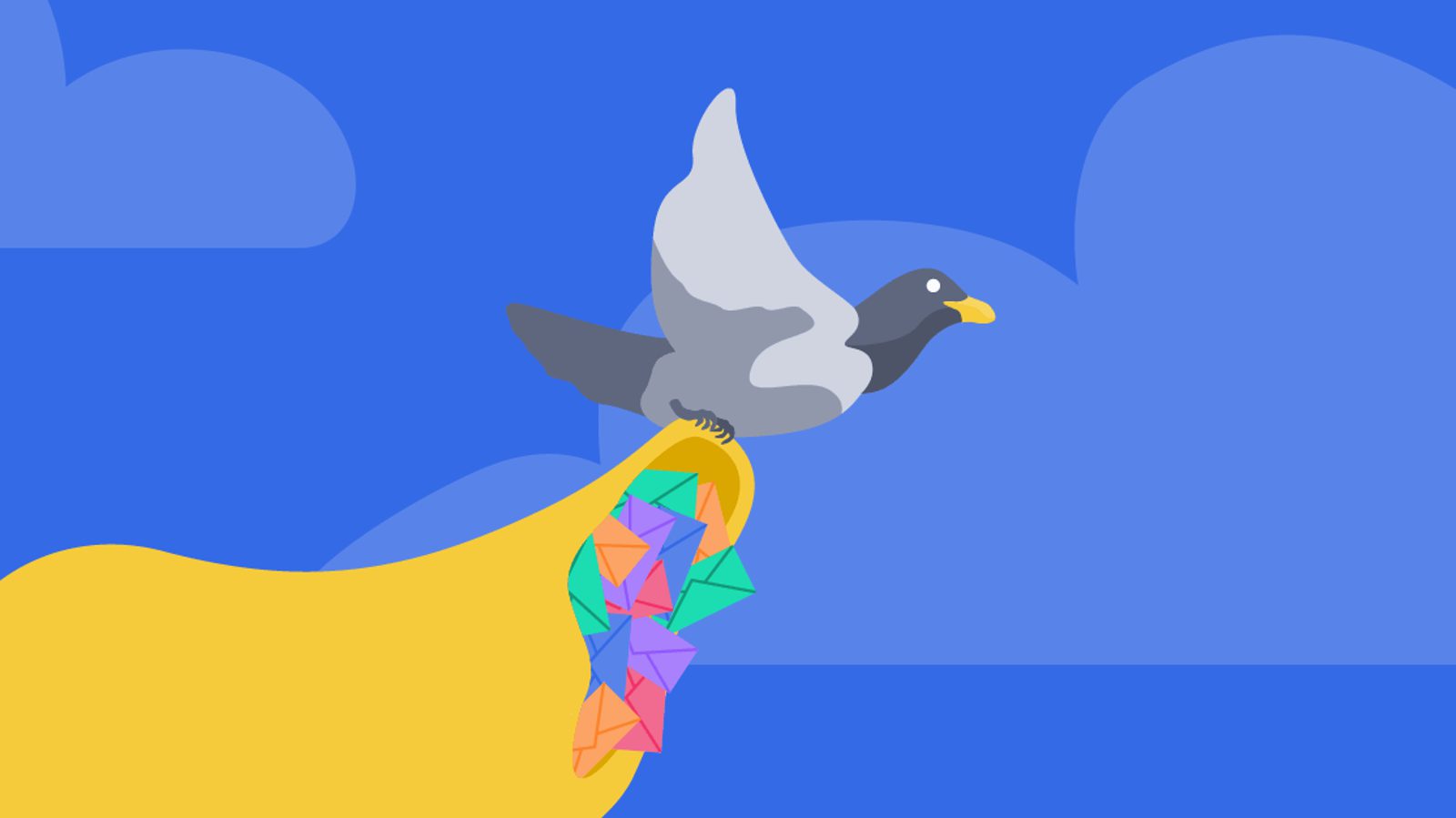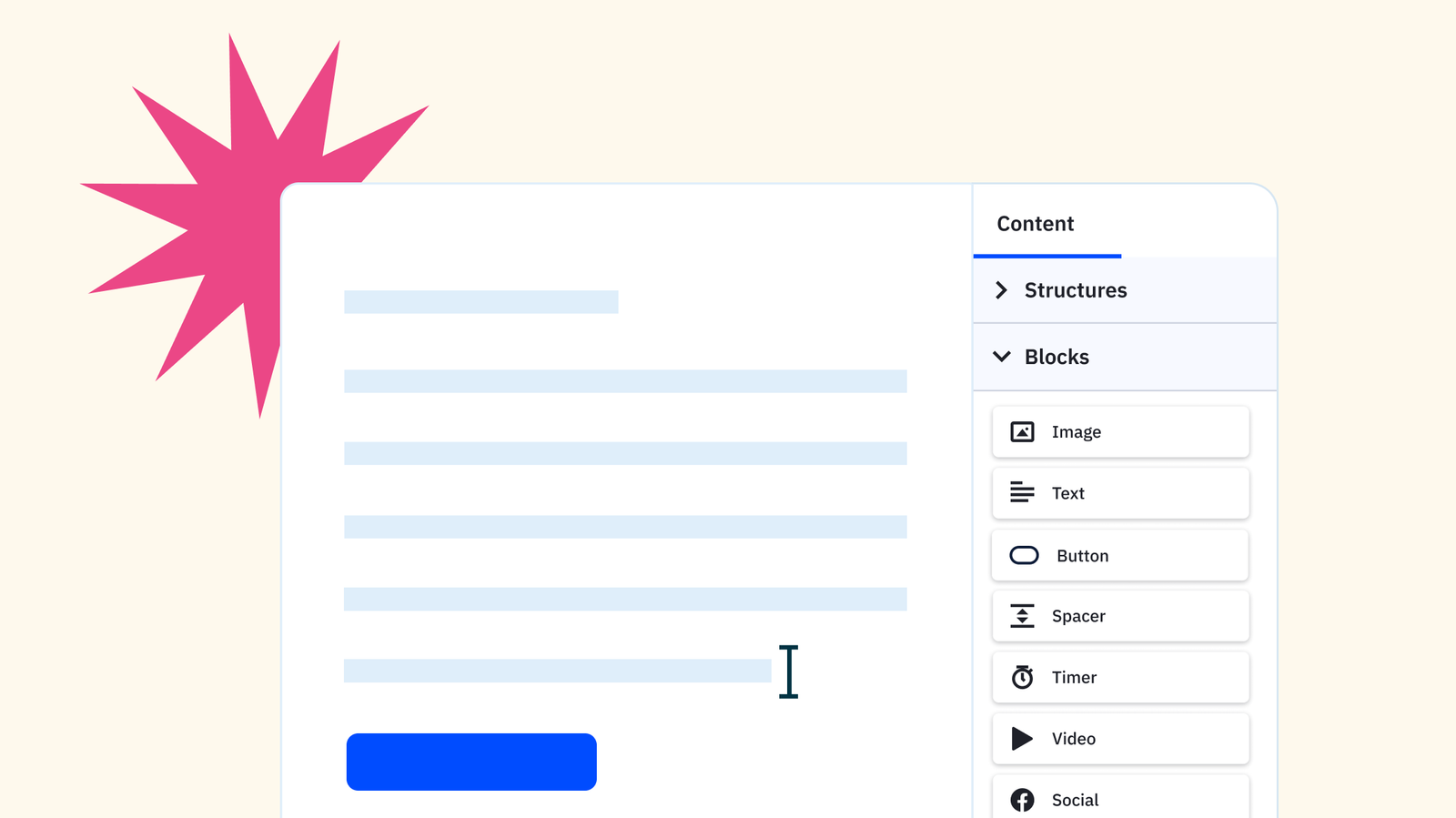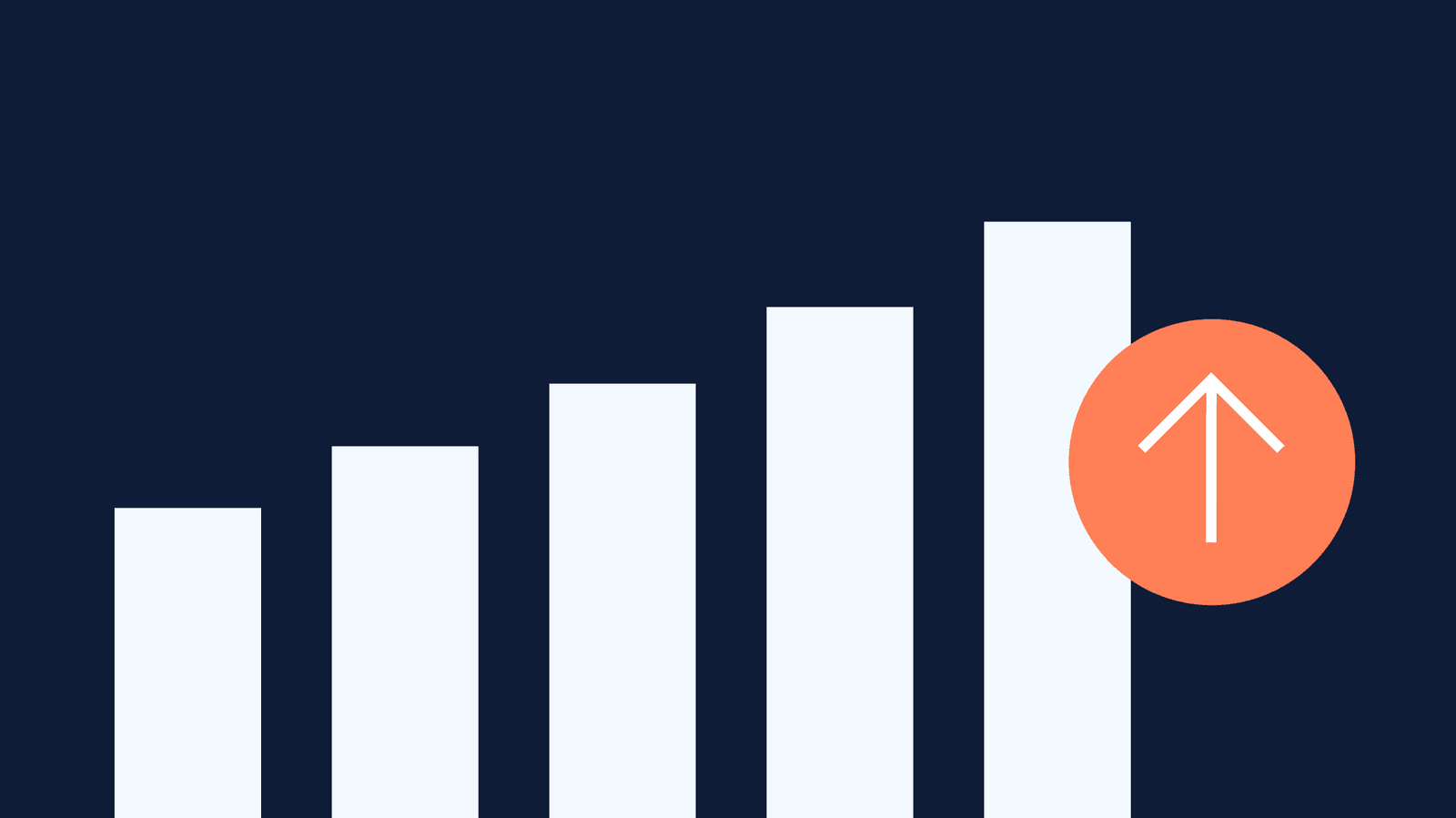You lose a quarter of your subscribers every year.
Sure, people unsubscribe. Everyone knows that. But you’re actually losing more people than you realize. Email unsubscribes aren’t the only way for you to “lose” your subscribers. Research from Marketing Sherpas shows that email list decay costs you about 22.5% of your subscribers per year.
Loren McDonald, of IBM Marketing Cloud, argues that you lose 10% to 25% of your subscribers on top of that. Not because they unsubscribe – but because they stay subscribed and stop interacting with you.
These people are ignoring you, and you might never know it. Sure, it could be because of increasingly crowded inboxes, uninspiring email blasts, or inbox placement rates (hello "promotions" folder!), but a re-engagement email sequence can win them back.
What is a re-engagement email?
A re-engagement email can go by a few different names:
A re-engagement campaign is a sequence of emails sent to inactive subscribers. The goal of a re-engagement email is to get people to interact with your emails.
To write this post, we surveyed ActiveCampaign Certified Consultants about the best ways to use re-engagement emails. You’ll learn things like:
- How many re-engagement emails should you send before unsubscribing your contacts?
- How long should you wait between re-engagement emails?
- How long do you wait before sending a re-engagement email?

Our experts were all over the map, but a healthy waiting period 31-60 days before sending a re-engagement email was the most popular option.
To re-engage people, you need to understand why they tune out in the first place. It’s usually one of these reasons:
- Poor engagement rate — Too many emails
- Clickbait email subject lines
- Unengaging email preheader text
- Confusing design
- Not optimized for mobile (check out these responsive email templates)
- Poor content engagement — Repetitive or irrelevant content
- Poor subscriber engagement — Only signed up for a one-time offer
“It's critical to understand that people disengage for one of two reasons: either their needs change or your emails aren't meeting their needs. – Stephanie Nivinskus, Sizzleforce Marketing
Re-engagement emails give you a huge bang for your buck – set them up once and then they work for you. The key benefits are:
- Turning an inactive subscriber into a customer is 5 times cheaper than acquiring a brand-new customer
- Your deliverability sucks (and your emails go to spam) if you send emails to inactive subscribers
Wish your email software sent re-engaged subscribers automatically?
It’s not just a re-engagement email – it’s a re-engagement email sequence
When you sign up for a service, you probably get a series of emails asking you to...
- Get your new account set up
- Return to your abandoned online cart
- Shop a flash sale BEFORE IT’S GONE!
- Give feedback on a purchase
Those are all part of an email sequence.
Instead of sending one email and hoping for the best, the smartest businesses use a series of emails to get you to take the right actions.
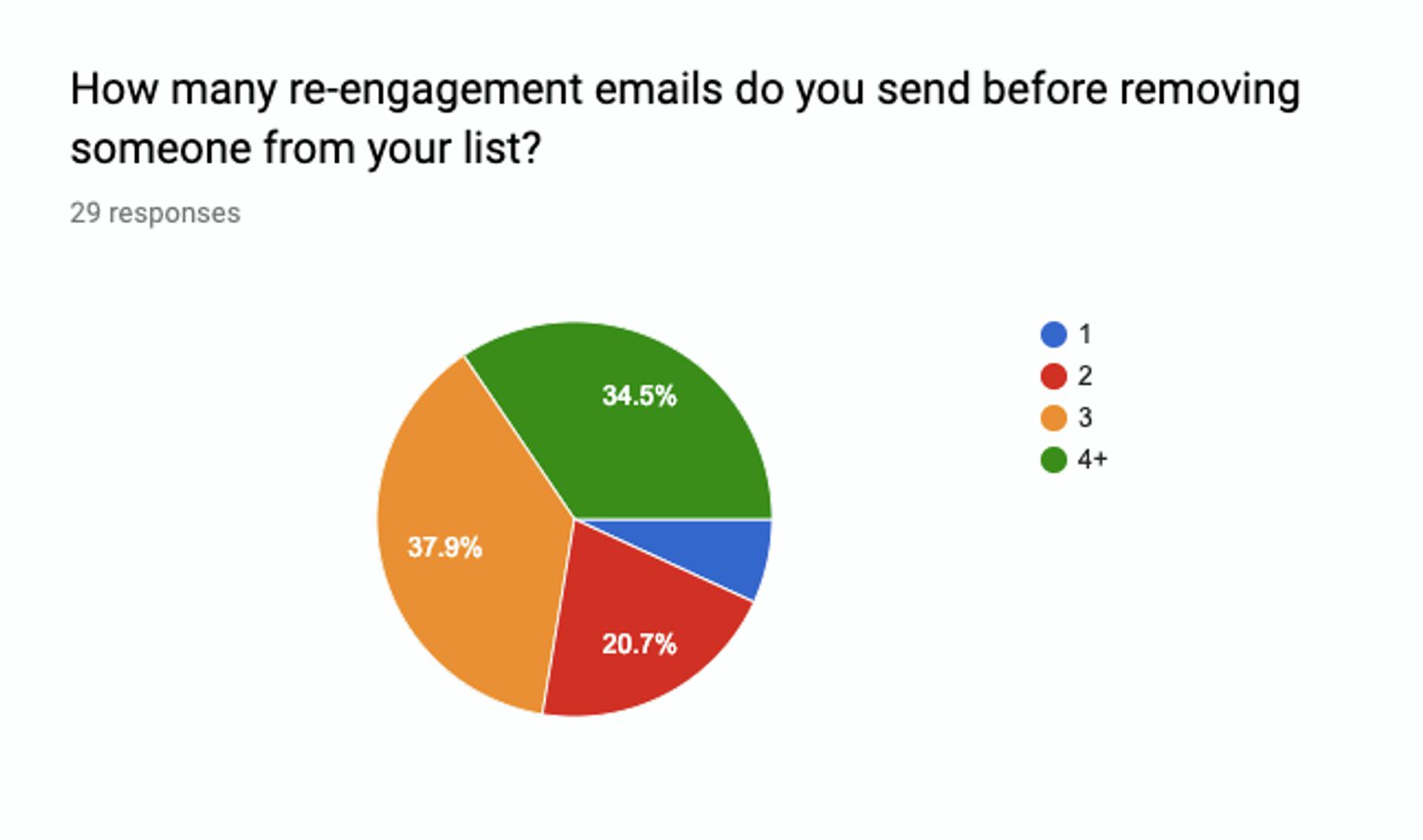
ActiveCampaign experts prefer to send 3+ re-engagement.
When you’re trying to re-engage your quiet customers, it probably seems counter-intuitive to send multiple re-engagement emails instead of a single one. That seems kind of clingy or desperate, right?
Not in this case. Sending an email sequence is actually the opposite (if you do it right) and gives subscribers more options for engagement.
People need reasons to stick around. It’s not enough to send an email that says “Please come back” – you have to show them why it’s worth their time. And that’s not something you can accomplish in a single email.
NOTE: Each individual email in the sequence should have its own message centered around the theme of getting back together. Too many ideas in one email are overwhelming.
If you jump around from free content to a flash sale and make a pit stop to offering a discounted subscription rate (all in one email), people won’t know where to look first.
An email sequence lets you cover all the bases without shoving too much down a customer's throat with one email.

Good luck not getting lost.
Email marketing produces the highest ROI out of most digital outlets – in fact, the average order value of a purchase from email is at least three times higher than one from social media, according to McKinsey.
A re-engagement email sequence is essential for the health of your email lists and your subsequent email ROI.
What should your re-engagement email campaign look like?
You should probably send a re-engagement email sequence of 3+ emails starting 30-60 days after a subscriber becomes inactive.
But what should those emails look like? Sound like? Here’s some advice from an ActiveCampaign expert on how to send effective re-engagement emails.
“Don't overthink it. People have a hard time with email because they make a big deal out of it. It's just another medium for conversation. Think of ONE person you would love to respond and write to them. My subscribers often tell me they can't tell if my emails are personal or campaigns. Keep it simple. Sometimes a 9-word email just asking them if they're still interested in [benefit of your product or service] will get them to re-engage. Lastly, a little humor never hurts!” – Kronda Adair, Karvel Digital
Quick marketing lesson: Dean Jackson’s 9-word email
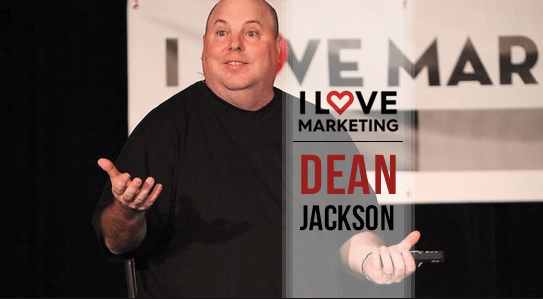
Dean Jackson, a successful real estate entrepreneur, online marketer, and co-host of the I Love Marketing podcast developed a 9-word email to revive dead leads and re-engage customers.
This kind of short email technique follows what he calls the Starbucks Test. Say you initially met with a prospect or current customer and that interaction didn’t work. If you see them again later, what would you say to them to make it work this time?
The subject should just be their first name, ie. “Bob”.
Then the body of the email goes like this:
"Hi [First Name], Are you still looking for ___ (enter what you sell in 2 words)?"
And that’s it. Short and simple.
Some examples of this are:
- “Are you still looking at growing your blog traffic?”
- “Are you still interested in improving home security?”
- “Are you still looking to have your home painted?”
- “Are you still considering buying a new car?”
Val Geisler, an email marketing strategist and conversion copywriter, did a detailed re-engagement sequence breakdown of Jill Stanton (owner of the popular blog Screw the 9 To 5).

Need a killer subject line like these? Try our totally free Subject Line Generator tool.
Here’s a look at two of the four emails she got from Jill.
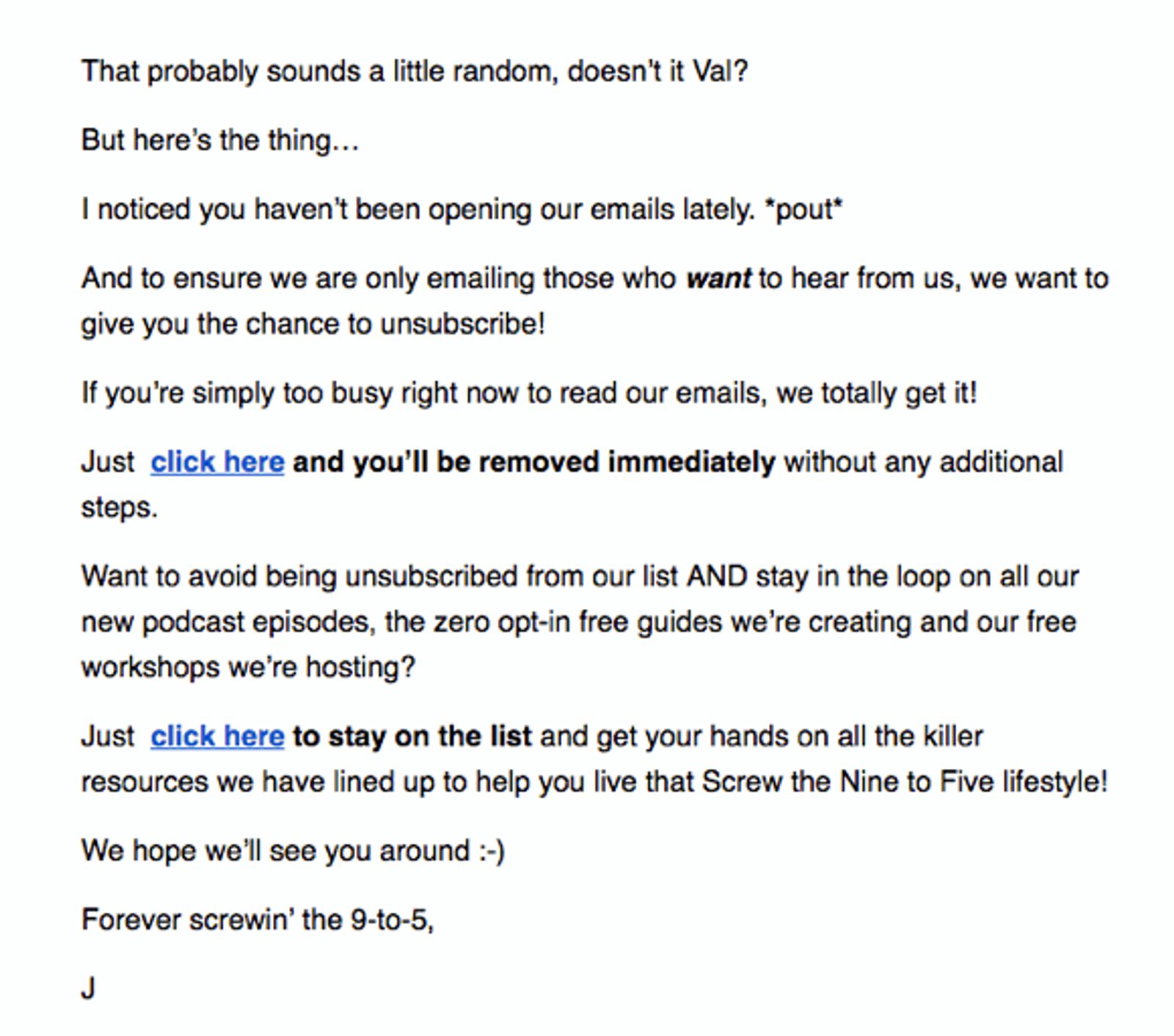
*Pout* Personal additions are part of what makes any email (and especially a re-engagement email) effective.
Then two days later with a follow-up email…

YAY! *Fist pump* this is a good re-engagement email
Here’s why Val says that these emails work:
- It's a clear message
- It’s personalized
- It uses Jill’s brand voice
- It includes link triggers to stay on the list or be removed
- The second email reiterates the same email from two days prior
Writing different types of emails? Click here to learn how to format different kinds of emails.
Here’s an idea of what your automated re-engagement email sequence can include.
- Reminder: The initial email that opens the win-back email campaign
- Review: Ask them to review their email preferences (so they can choose the email frequency they want)
- Receive: Offer them something for free (and put your offer in the subject line)
- Regrets: It’s time to say goodbye and unsubscribe them...but give an option to come back in case they change their mind
Once you have your re-engagement email campaign fleshed out, automate it.

If you use ActiveCampaign, you can import a free, pre-built re-engagement email sequence by clicking here.
What if your re-engagement sequence doesn’t work? It’s time for email list cleaning.
Before you decide to take those email subscribers from your list though, remember this: There are recipients who open the re-engagement emails up to 300 days from the day you sent it.
In fact, 75% of these subscribers will open the messages within 89 days of receiving them.
So decide how long you want to wait after sending your re-engagement email, then be ready to clean.
Re-engagement email best practices
Here are 7 best practices you should definitely use in your re-engagement emails:
- Personalize your copy – Use their name, sure, but hammer home the benefits they care about. And as long as your message is still clear, feel free to make it funny!
- Segment your list of inactive subscribers – You might need a different re-engagement automation for different types of people depending on if they open but don’t click, or if they do both
- Target emotions – Remind them of the painful problems you’ve helped them with (feel free to use guilt or nostalgia)
- Offer another way to stay in touch – Let people update their email preferences or take a short email hiatus – it might avoid an unsubscribe
- Offer them something for free – A content upgrade, a discount, a giveaway, a free trip to Hawaii (just kidding…)
- Remind them why they signed up – Reiterate the problem you can solve for them – then give them the fix they need
- Include a good and visible unsubscribe option – It feels counter-intuitive, but you still have to give them the option to unsubscribe. It’s nice, and not having it is illegal…)
Here are seven killer re-engagement email examples that put these best practices into action.
7 re-engagement email examples to win back hearts, minds, and opens
1. JetBlue

What’s good about this re-engagement email:
- It’s personalized with the word “you”
- It targets emotions (breakups ARE hard and emotionally draining)
- It offers alternatives to unsubscribing (BUT it still gives an unsubscribe option, which is important)
2. Kate Spade

What’s good about this re-engagement email:
- This email goes to Kate Spade’s inactive subscribers – but it’s segmented so that it only goes to subscribers who get emails in the Gmail promotions tab
- The curiosity-inducing CTA teases updates to come (an incentive to open the next email too)
3. Teespring

“Just approach it like a one-to-one conversation. Remind them why they joined your list and that your goal is to help them achieve something.” – Prashant Murphy, Unlimitly.com
What’s good about this re-engagement email:
- It gives you examples of your success, which is a good reason to stick around (“You’ve sold 214 products or $6016.39 in total sales.” “You’ve also averaged a 50% overall success rate.”)
- It appeals to your emotions with an adorable puppy
4. David Lloyd

What’s good about this re-engagement email:
- Again with those sad eyes...they just tug at your emotions!
- The “come back to us” CTA copy is actionable and personal
5. Venmo

What’s good about this re-engagement email:
- Instead of just addressing a problem (splitting a bill) it gives you a benefit you can use right away
- Pizza emoji. Nothing like a delicious, visual reminder of what you could have immediately.
6. Urban Outfitters
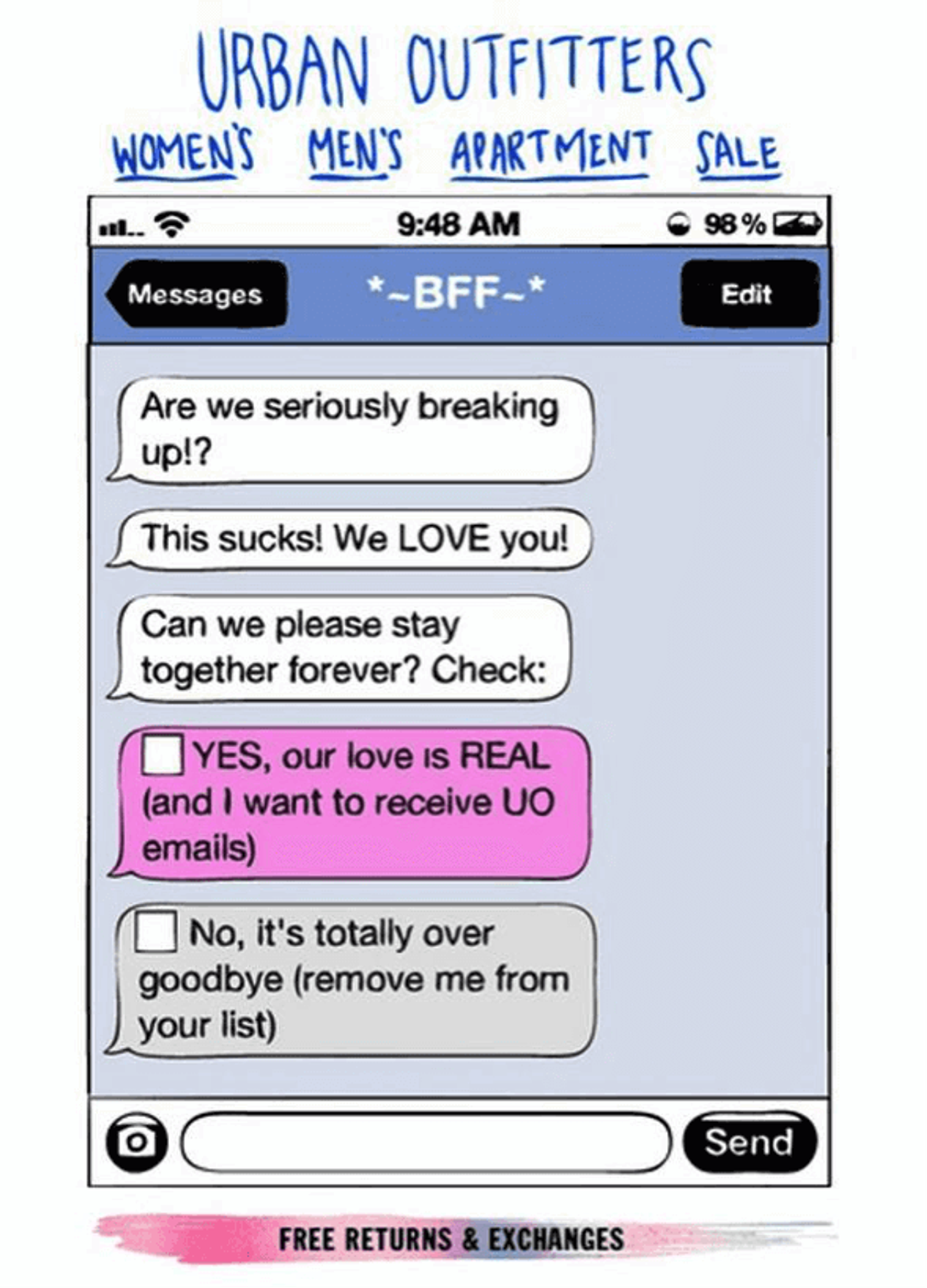
“The more personally you can reach that disengaged contact and demonstrate an awareness of who and where they are, the more likely you are to re-engage them.” – Skip Shean, 16Wells
What’s good about this re-engagement email:
- It targets emotions AND a specific audience (the texting design and copy appeal to a younger, hipper demographic)
- It gets personal. Personal, conversational emails are more engaging.
7. Lowe's
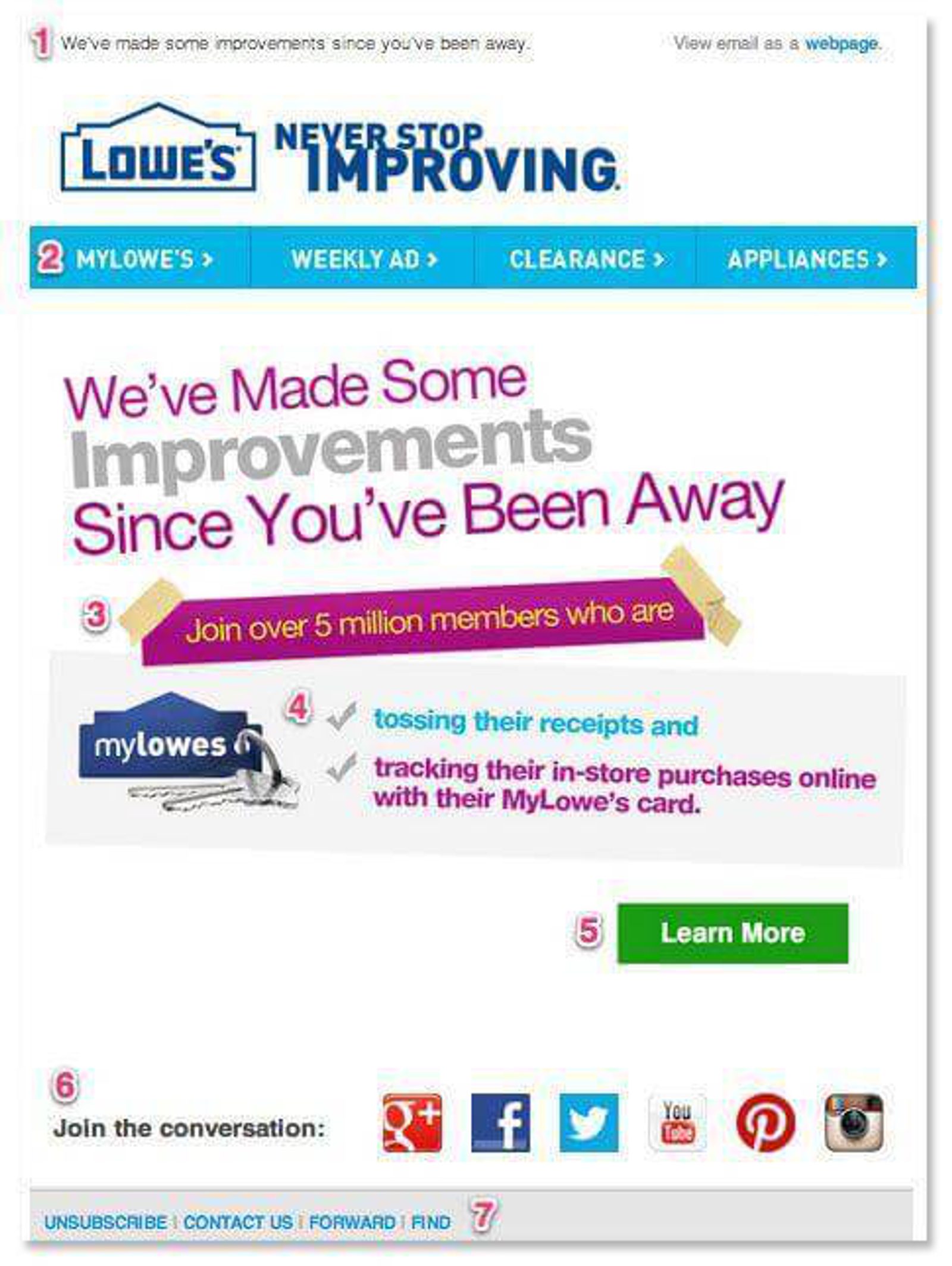
What’s good about this re-engagement email:
- Lowe’s highlights the improvements they’ve made since you left – and they prove it by telling you 5 million others are already with them
- It fixes a problem that customers may not have even realized they had (toss those receipts along with everyone else, you don’t need ‘em!)
The best re-engagement email tip? Keep them engaged in the first place (here’s how…)
You always need a re-engagement email plan in your back pocket. Some people will always stop opening. But, you can be proactive and keep those numbers down.
Here are the four key ways to keep your subscribers engaged:
- Check where your subscribers come from – are some sources getting you more inactive subscribers?
- Check your opt-in practices – make sure you’re only emailing people who want to hear from you
- Check your welcome email series to see if its instructions and resources were clear enough to get people started
- Have a plan, like a regular list-cleaning check, to make sure you clean inactive subscribers off your list
And finally…one of the most universally applicable pieces of marketing advice you’ll ever hear:
“Test endlessly. You're never right on your first try.” – Chloé Hamel de Monchenault, Okisam
Ready to get started? Try us out for free and sign up for a trial in the box to the right →

